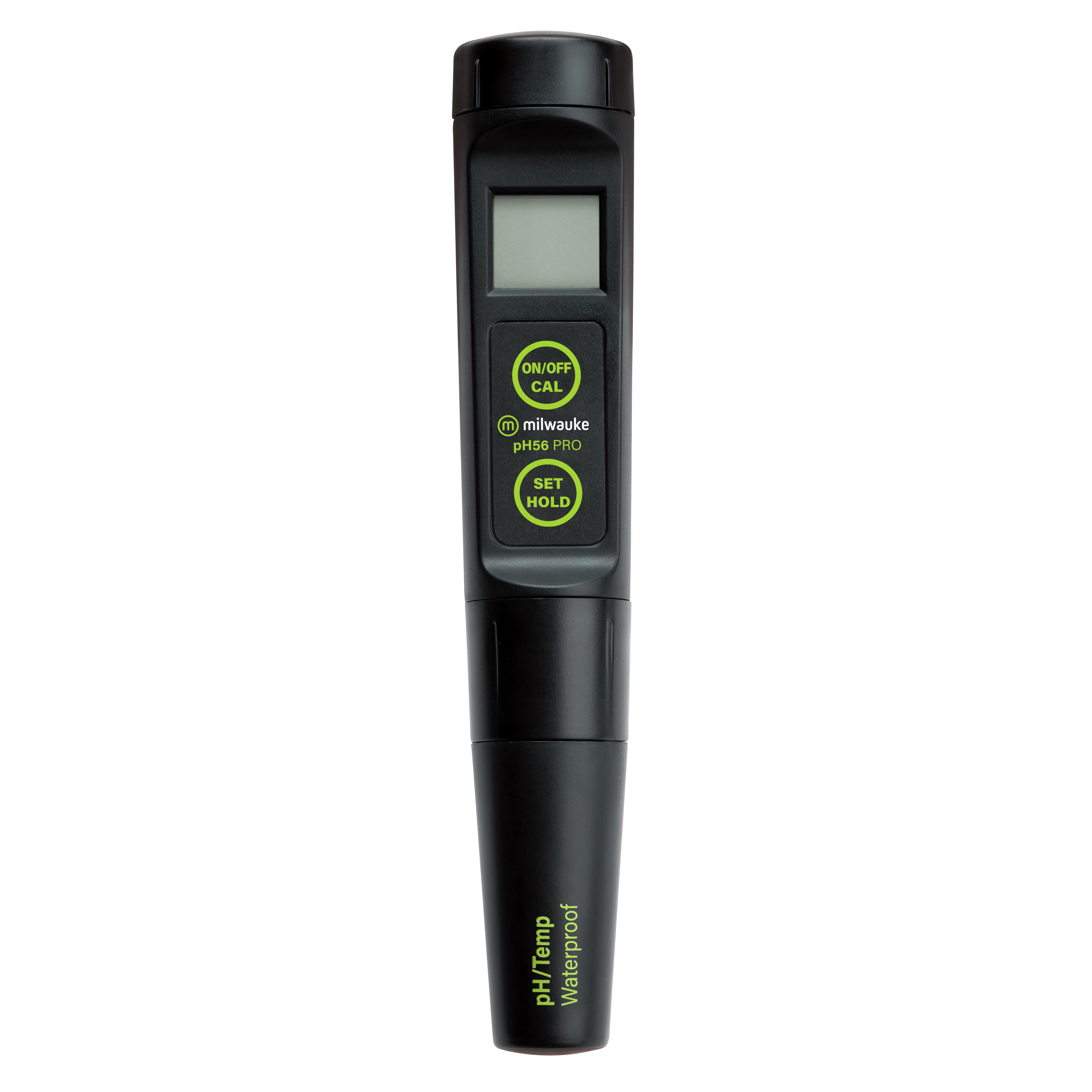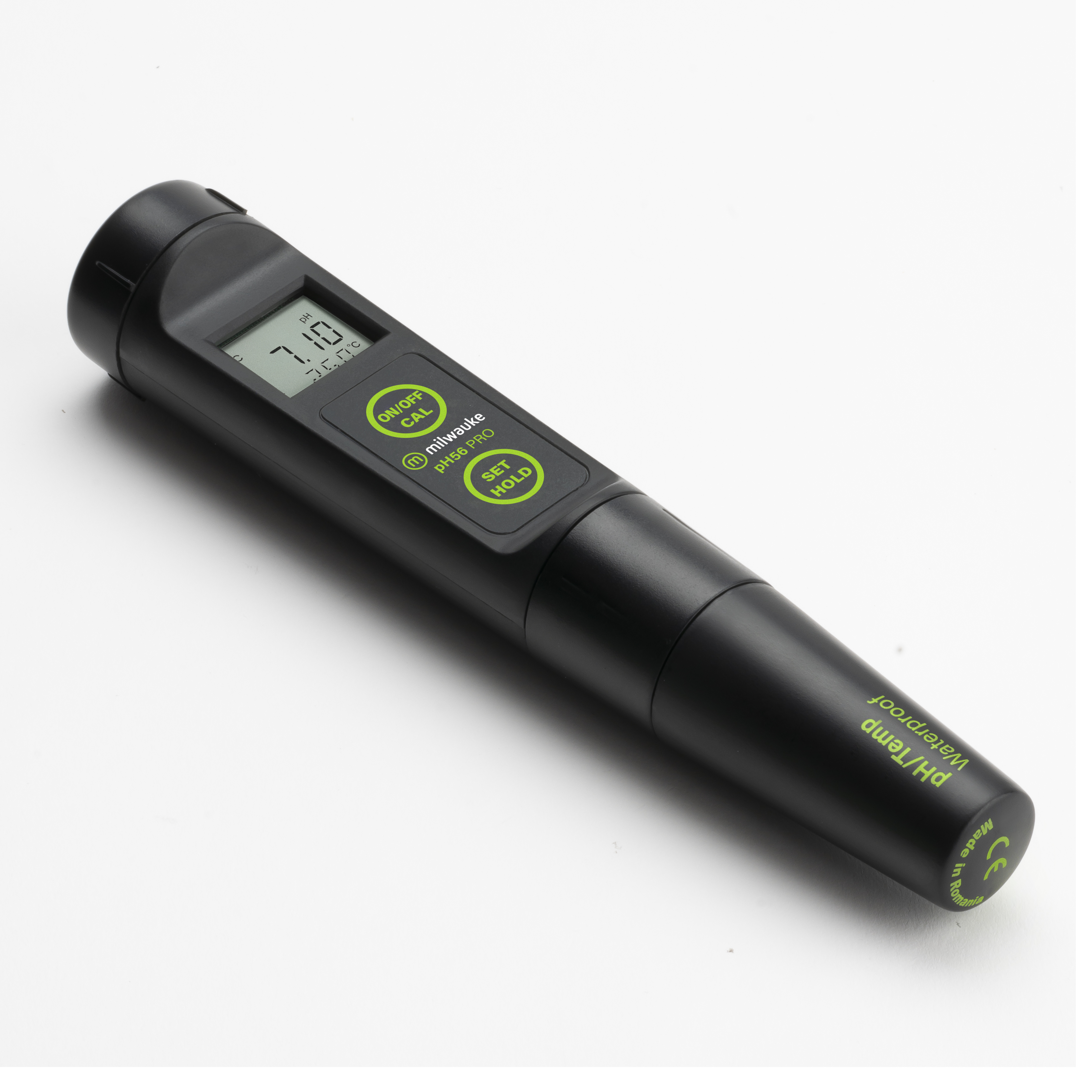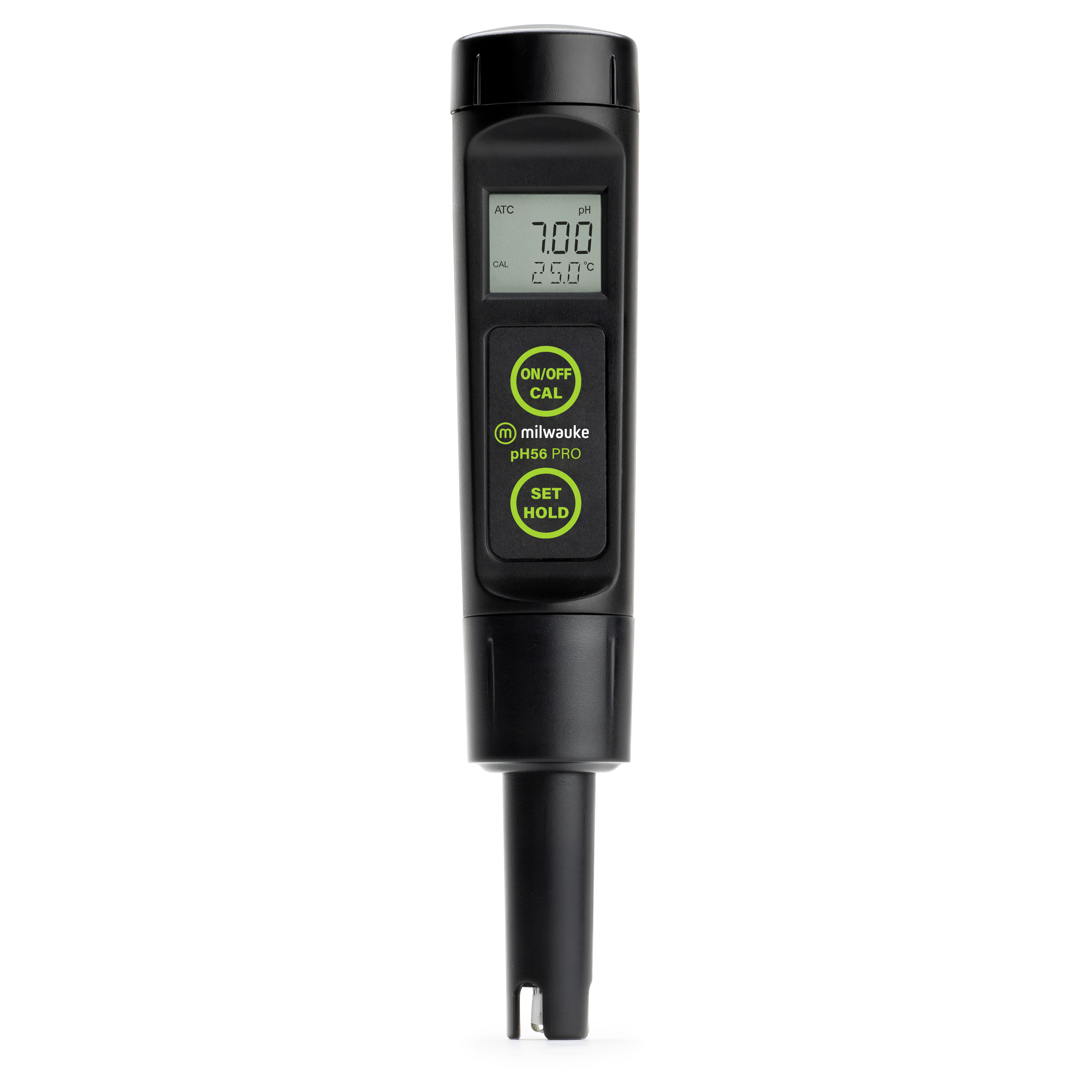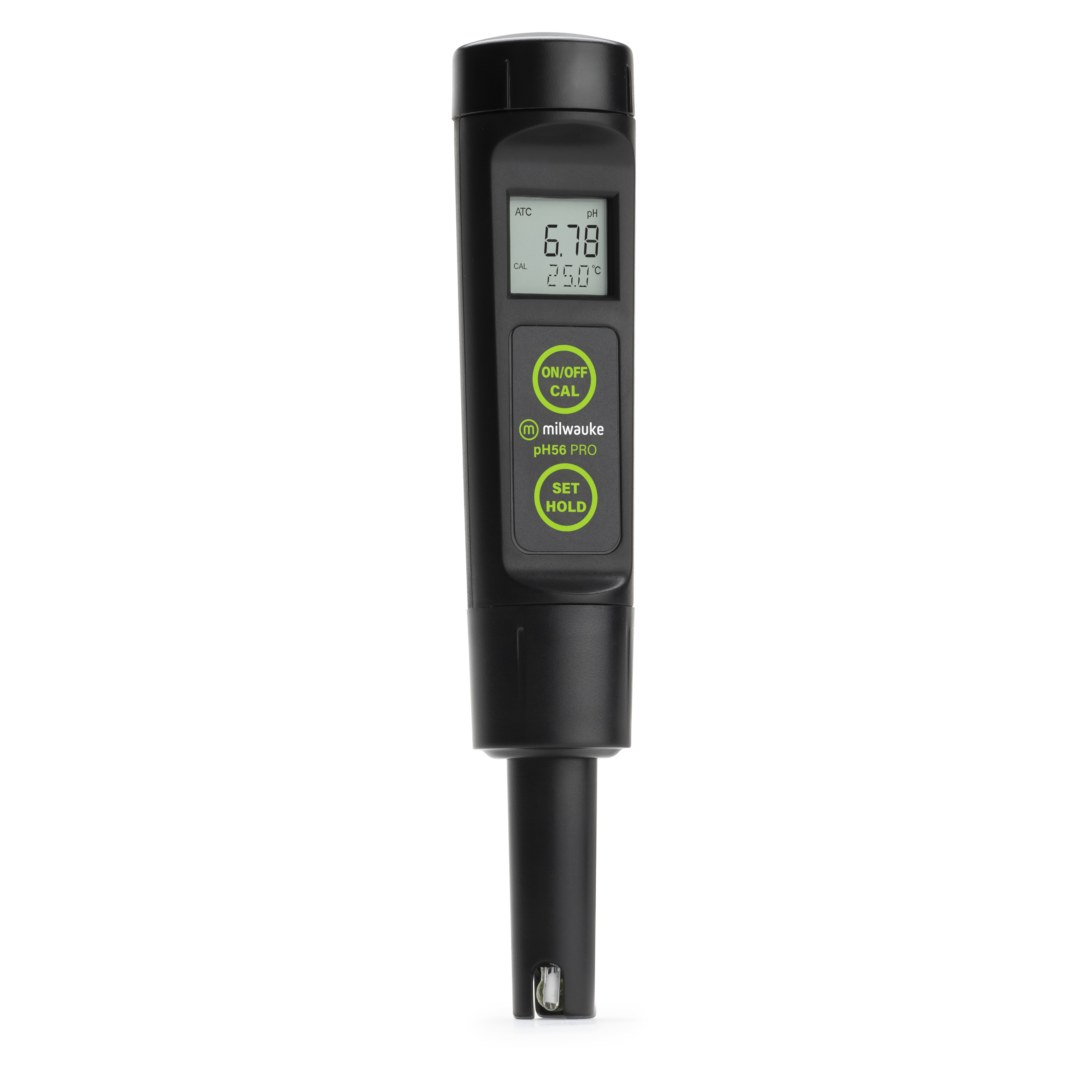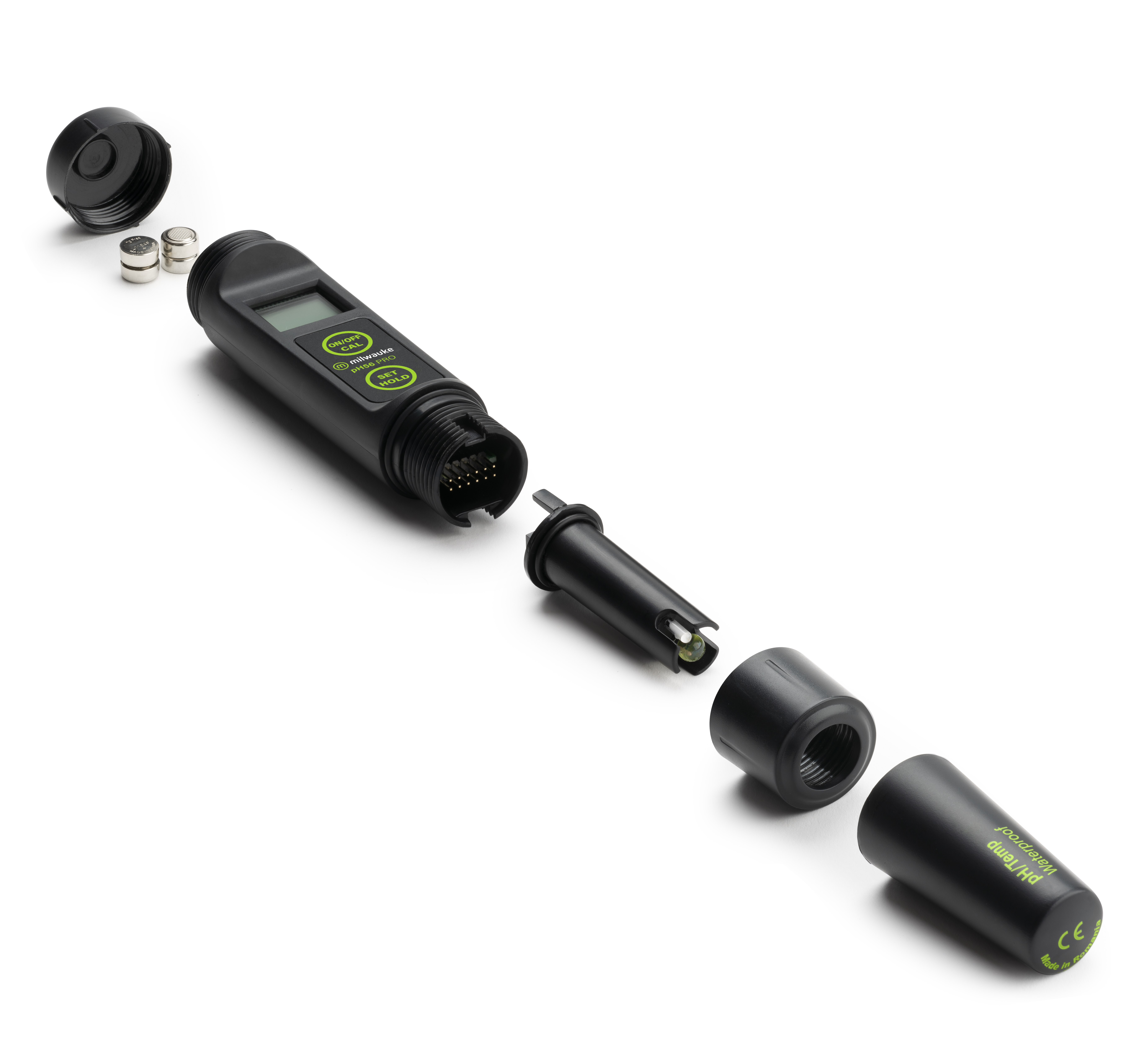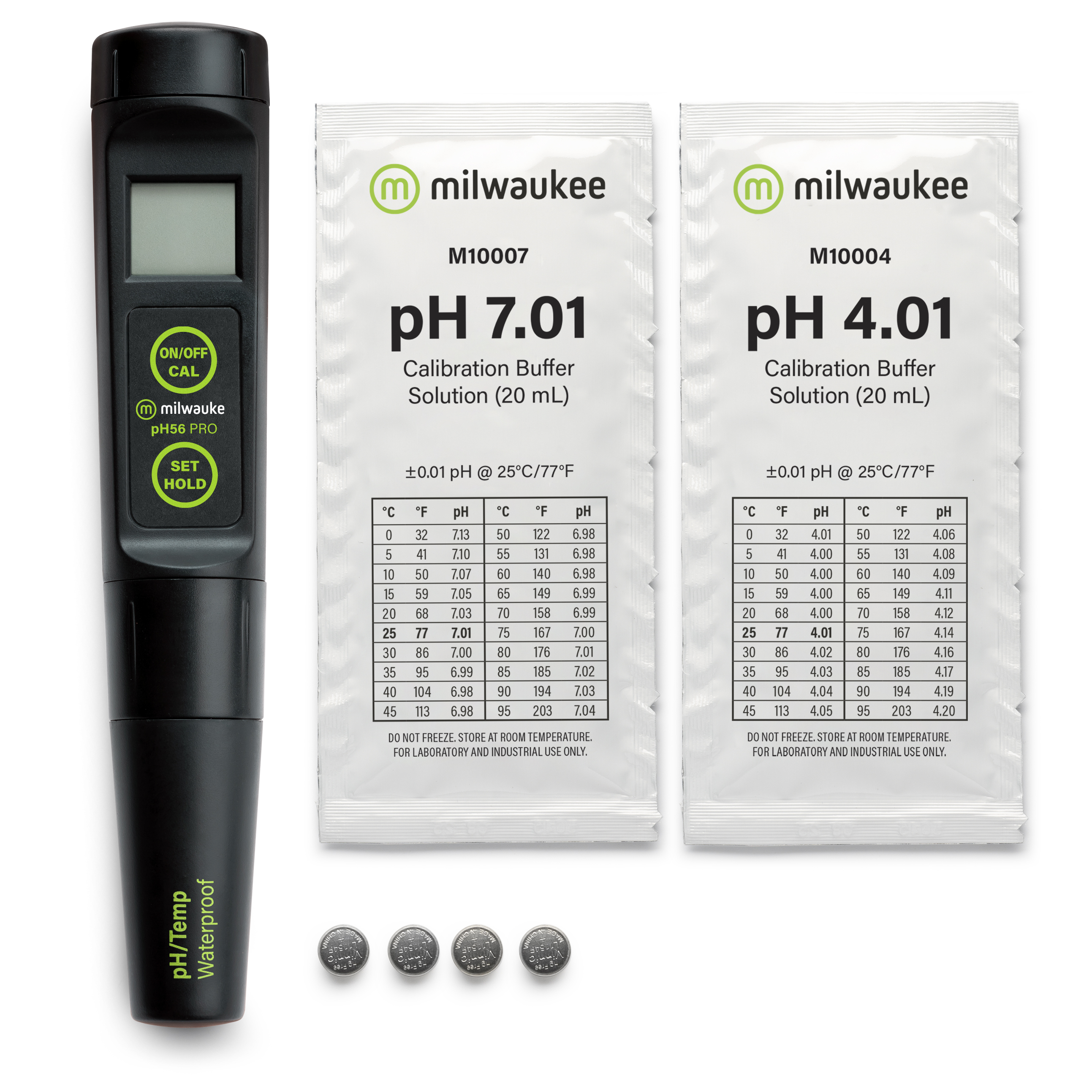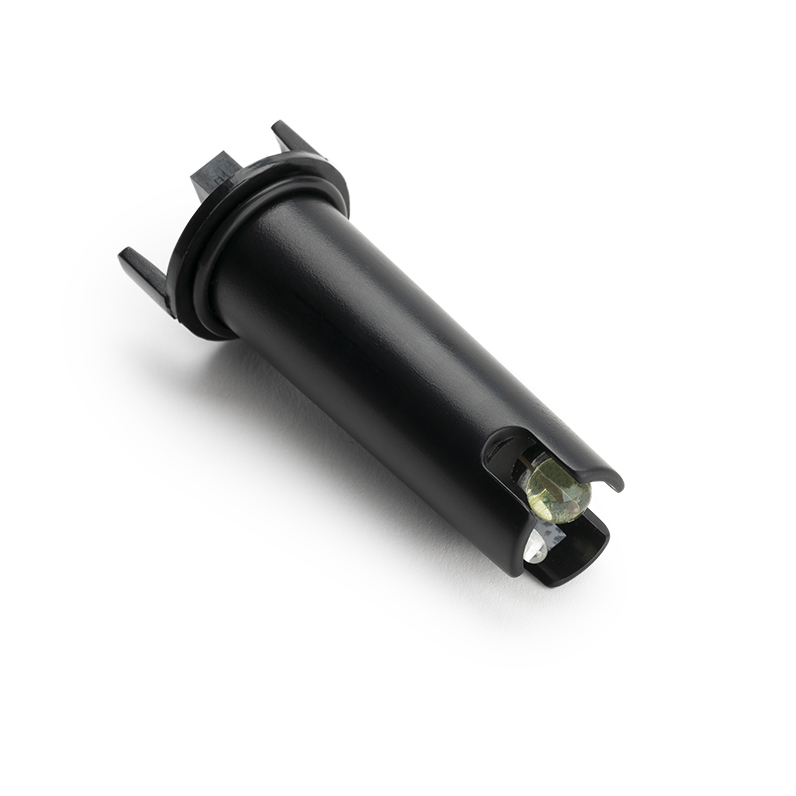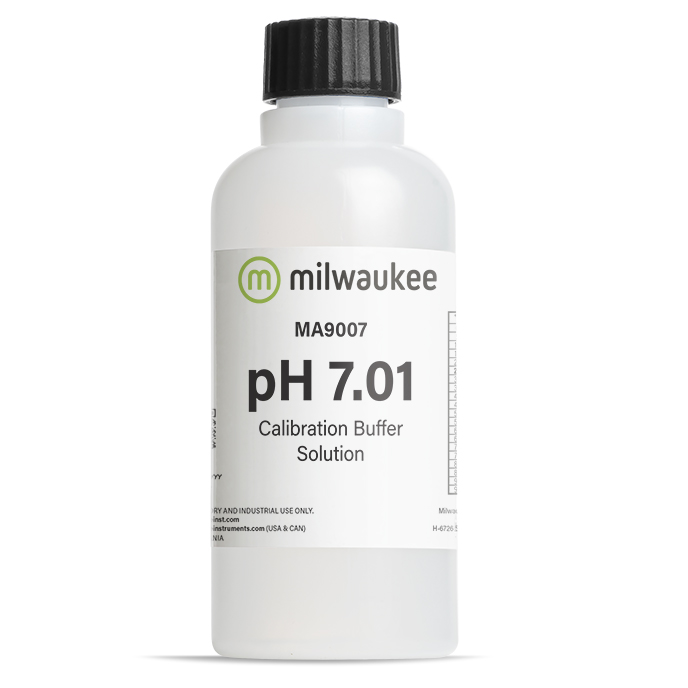Your shopping cart is currently empty.
Milwaukee PH56 Waterproof pH/Temp Tester – Precision Testing in the Palm of Your Hand
When it comes to testing pH and temperature, accuracy, speed, and portability are everything – whether you’re fine-tuning a brewing process, adjusting hydroponic nutrients, testing aquarium water, or checking environmental conditions in the field. The Milwaukee PH56 was designed with one mission in mind: to provide professionals and enthusiasts with a rugged, reliable, and ultra-precise testing companion that fits in your pocket.
Engineered for users who demand reliability in tough environments, the PH56 combines laboratory-grade accuracy with the simplicity and portability of a compact tester. Its waterproof housing, dual-level LCD display, automatic temperature compensation (ATC), and replaceable double-junction pH electrode make it ideal for fast, accurate readings across a wide variety of applications.
Whether you're monitoring fermentation, growing high-yield crops, or maintaining clean, balanced water in aquaculture or pools, the PH56 gives you the confidence to make critical decisions with precision – anywhere, anytime.
Why Choose the Milwaukee PH56?
- High
Accuracy & Resolution
Measures pH from –2.00 to 16.00 with an accuracy of ±0.05 and resolution of 0.01 pH – ideal for demanding environments where precision matters. - Dual-Level
LCD Display
Simultaneously view pH and temperature readings on a large, easy-to-read screen – designed for clear viewing even in bright outdoor conditions. - Automatic
Temperature Compensation (ATC)
Compensates for temperature differences automatically, giving you more accurate pH readings across a range from –5.0 to 105.0 °C. - Replaceable
Double-Junction Electrode
The PH56 features a high-quality, replaceable electrode designed to handle tough samples with minimal contamination and extended probe life. - Waterproof
IP65 Housing
Built to withstand wet conditions and accidental splashes, making it perfect for fieldwork, industrial use, and lab environments alike. - Compact,
Lightweight, and Portable
Weighing just 100 g (3.5 oz), it fits comfortably in your pocket or tool kit, with a protective cap and auto-shutoff to save battery. - One
or Two-Point Calibration
Quick and easy automatic calibration at one or two points, using built-in buffer recognition to maintain reliable performance.
Applications
The Milwaukee PH56 is a highly versatile tester trusted across numerous industries and fields:
Brewing & Wine making
Achieve perfect pH control for wort mash, fermentation, and bottling in beer, wine, cider, and kombucha production. An essential tool for both craft brewers and commercial facilities.
Hydroponics & Agriculture
Maintain optimal pH levels in nutrient solutions to maximize plant health, yield, and growth rate in soil-free growing systems and greenhouse operations.
Aquariums & Aquaculture
Keep aquatic environments healthy and balanced. Essential for monitoring water parameters in fish tanks, reef systems, and aquaculture ponds.
Pools, Spas & Water Maintenance
Test and regulate pH in swimming pools, spas, and fountains to ensure user safety, equipment longevity, and water clarity.
Environmental Monitoring
Used by field researchers and environmental engineers for quick testing of natural water sources, soil slurries, runoff, and wastewater.
Food & Beverage Processing
Ensure consistency and safety in dairy, cheese, sauce, and beverage production. The PH56 supports quality control and pH-critical recipe accuracy.
Laboratories & Research
Ideal for student labs, academic experiments, and R&D projects requiring reliable and portable pH measurement tools.
Proper Care & Maintenance
To keep your PH56 operating at peak performance, proper maintenance is essential – especially for the pH electrode, the heart of your tester.
Storage
Always store the electrode in a proper pH storage solution or pH calibration buffer – not in tap or deionized water, which can damage the glass bulb and clog the reference junction. Use the protective cap with solution inside, and store the unit upright when possible.
Cleaning
Regularly clean the electrode, especially after exposure to oily, sticky, or organic-rich samples. Use a specialized pH cleaning solution to prevent residue buildup and maintain electrode sensitivity.
Calibration
The glass sensing bulb becomes less sensitive over time. To ensure measurement accuracy, calibrate the tester frequently – especially after storage, cleaning, or intensive use. The PH56 supports quick automatic calibration using one or two standard buffer solutions.
Replacement
If the readings become erratic or the electrode is damaged, replace the electrode with a compatible double-junction probe to restore optimal performance.
Trust the Milwaukee PH56 for fast, accurate, and reliable pH and temperature measurements – designed for those who take water quality seriously. Whether in the lab, on the farm, or out in the field, it’s your go-to tool for professional-grade results.
Specifications
Application
Brewing & Winemaking
Precision pH control is at the heart of successful brewing and fermentation. Both homebrewers and commercial producers understand that pH plays a critical role in enzyme activity, yeast health, flavor development, and overall product stability.
During the mash phase of beer brewing, maintaining the optimal pH (typically 5.2–5.6) ensures efficient starch-to-sugar conversion by amylase enzymes. Deviations can lead to poor efficiency, off-flavors, or fermentation issues. Later in the process, during fermentation and conditioning, tracking pH helps assess yeast performance and detect signs of contamination.
In winemaking, pH influences everything from color intensity to microbial stability and shelf life. Lower pH wines tend to have brighter flavor profiles and better preservation, while higher pH values may lead to flat taste or increased spoilage risk. From grape crushing to barrel aging, pH monitoring is critical for producing balanced, high-quality wine.
Designed for both passionate brewers and experienced vintners, the Milwaukee PH56 delivers real-time, lab-grade measurements with ±0.05 pH accuracy and built-in automatic temperature compensation. It's compact, rugged, and ready for action across all stages of the fermentation journey – from boiling wort to chilled wine tanks.
How to Use the PH56 for Brewing & Winemaking
Calibrate Before Use
- Turn on the PH56 and ensure it’s clean and functional.
- Perform a 1- or 2-point calibration using pH buffer solutions (typically pH 4.01 and 7.01).
- Always calibrate at the same temperature as your sample or use ATC.
Rinse the Electrode
- Before taking a reading, rinse the electrode with distilled water to prevent cross-contamination from previous samples.
- Lightly blot dry with a lint-free cloth or tissue—do not rub.
Take Your Sample Measurement
- Submerge the electrode into your wort, must, or wine sample. Stir gently if needed.
- Wait for the reading to stabilize—usually within a few seconds.
- Read both pH and temperature on the dual-level LCD display.
Record and Act
- Compare your reading to target pH ranges:
- Beer mash: 5.2–5.6
- Fermenting beer: 4.0–4.5
- Wine must: 3.2–3.6
- Finished red wine: 3.3–3.5
- Finished white wine: 3.0–3.4
- Adjust with acid or base additions if necessary.
Clean After Use
- Rinse the electrode with distilled water after each test.
- Periodically soak in pH cleaning solution to remove protein and sugar residues common in brewing and winemaking samples.
Store Properly
- Always store the probe in storage solution (never dry or in plain water).
- Replace the cap filled with storage solution and tighten it after every use.
Water Quality Testing (Aquaculture, Pools, Tap Water)
Accurate pH measurement is fundamental to maintaining healthy and balanced water systems – be it in an aquarium, a commercial fish hatchery, a backyard swimming pool, or even the water flowing from your tap. The chemistry of water directly impacts aquatic life, equipment longevity, sanitation, and human safety.
In aquaculture and aquarium systems, stable pH is critical for fish health, biological filtration, and nutrient availability. Fluctuations – even minor – can stress or kill fish, disrupt beneficial bacteria, and reduce oxygen solubility. The PH56 helps aquarists and fish farmers monitor conditions quickly and take preventive action before problems arise.
In pools and spas, pH control is essential for effective chlorine disinfection, user comfort, and prevention of equipment corrosion or scale buildup. Water that is too acidic can erode plumbing and irritate skin and eyes, while water that is too alkaline may cause cloudy water and ineffective sanitation.
Tap water and other municipal sources are also worth testing regularly. Water suppliers aim for pH values around 7.0–8.5, but local variations, aging infrastructure, or private wells can result in unexpected shifts. Testing at the point of use ensures peace of mind, especially when water is used for drinking, cleaning, or irrigation.
From aquaculture systems to recreational pools and domestic water taps, the Milwaukee PH56 provides reliable, field-ready performance. Its wide measurement range (–2.00 to 16.00 pH), automatic temperature compensation, and waterproof design (IP65/IP67-rated) make it a trustworthy tool for daily use in a variety of water-related environments.
How to Use the PH56 for Water Quality Testing
Calibrate the Meter
- Begin by performing a 1- or 2-point calibration using fresh buffer solutions (e.g., pH 7.01 and 4.01 or 10.01).
- Calibration ensures consistent accuracy and is especially important if testing across different water types or temperatures.
Prepare the Probe
- Rinse the electrode with distilled water to remove residue or storage solution.
- Gently blot dry with a soft cloth or tissue – do not rub the glass bulb.
Measure the Water Sample
- Submerge the probe in your aquarium, pool, pond, or tap water sample.
- Stir gently to remove any trapped air bubbles around the sensor.
- Allow the display to stabilize – this typically takes just a few seconds. The dual display will show both pH and temperature.
Take Action if Needed
- Adjust with pH up/down products, filtration, or aeration depending on your application.
- In aquariums or aquaculture, avoid sudden pH changes – gradual correction is safer for aquatic life.
Clean and Store
- Rinse the probe after each use to prevent mineral buildup or biofilm.
- Periodically soak in cleaning solution to remove stubborn residues, especially in organic-rich environments (like aquariums or ponds).
- Always store the probe wet in storage solution to preserve sensor life.
Laboratory & Educational Use
In educational and laboratory environments, the need for accurate, repeatable, and easy-to-use pH and temperature measurement tools is essential – especially when precision influences experiment outcomes or product development. The Milwaukee PH56 is an ideal solution for schools, universities, research labs, and industrial R&D departments looking for a compact yet professional-grade instrument.
In classroom settings, the PH56 helps students explore fundamental chemistry concepts such as acids, bases, buffers, and solution equilibrium. Its intuitive interface, large dual-display, and quick stabilization make it perfect for demonstrations and hands-on learning. The ability to show both pH and temperature at the same time also reinforces real-world applications of thermodynamics in solution chemistry.
In research and development labs, the PH56 supports pH monitoring in a variety of experimental settings – from buffer preparation to material science, food and beverage testing, or soil slurry analysis. With a high resolution of 0.01 pH and accuracy of ±0.05 pH, researchers can trust the data they’re collecting without needing a bulky benchtop meter.
Thanks to its waterproof construction (IP65/IP67) and replaceable double-junction electrode, the PH56 can handle repeated daily use while minimizing contamination risks between different test solutions. Its portability makes it especially useful for field research, off-site sampling, or mobile STEM outreach labs.
Common Educational Applications of the PH56
1. Chemistry Labs
In both high school and university-level chemistry, pH is a core topic. The PH56 allows students to:
- Monitor the progress of acid-base titrations.
- Test buffer solutions and understand their capacity.
- Observe how temperature affects pH using the built-in ATC (Automatic Temperature Compensation).
- Reinforce concepts like the Henderson-Hasselbalch equation and equilibrium constants in practical settings.
Its ±0.05 accuracy and 0.01 resolution support reliable data collection and analysis—even in introductory or AP-level courses.
2. Biology & Environmental Science
In biology, understanding pH is critical to the function of enzymes, cells, and ecosystems. The PH56 is ideal for:
- Testing pH of biological samples (e.g., saliva, fermentation broths, or nutrient solutions).
- Monitoring soil and water pH in ecology or field biology experiments.
- Studying microbial growth environments and how pH affects metabolic activity.
- Observing photosynthesis and respiration rates in aquatic ecosystems by tracking CO₂-driven pH changes.
The waterproof, portable design allows students to use the tester both in the lab and outdoors during environmental surveys or water testing.
3. Food Science & Nutrition
Students in culinary science, nutrition, and food tech programs use the PH56 to:
- Test acidity of fermented foods like yogurt, sauerkraut, or kombucha.
- Evaluate preservation and spoilage risks by monitoring pH in meats, dairy, and sauces.
- Understand how pH affects taste, color, and texture in processed foods.
- Learn regulatory standards for food safety, such as the requirement to maintain pH below 4.6 for shelf-stable acidified foods.
The PH56’s fast stabilization time and easy cleaning make it suitable for use with sticky, acidic, or protein-rich food samples.
4. Soil & Agricultural Science
For students in agronomy, horticulture, or sustainable agriculture programs, soil pH is a major factor in crop health and nutrient uptake. The PH56 is used to:
- Test soil slurries or nutrient solution pH in classroom hydroponic or greenhouse setups.
- Compare pH effects of different fertilizers, composts, or amendments.
- Examine the relationship between soil pH and micronutrient availability.
- Teach field sampling techniques and proper probe handling.
Its durable waterproof casing and replaceable electrode ensure reliable use in both clean labs and messy soil testing environments.
How to Use the PH56 in Lab & Education Settings
Calibration
- Start by calibrating the PH56 with two standard buffer solutions (typically pH 7.01 and 4.01 or 10.01).
- Calibration should be done at the beginning of each lab day or before each class to ensure consistent accuracy.
Prepare the Instrument
- Rinse the probe in distilled water to remove storage solution or any residual ions from previous measurements.
- Lightly blot dry with a soft, lint-free tissue—avoid touching or rubbing the glass bulb.
Sample Measurement
- Submerge the probe in your test solution—whether it’s a beaker of vinegar, a soil-water extract, a protein solution, or a synthetic buffer.
- Stir gently to remove trapped air bubbles and allow the temperature reading to stabilize.
- Observe the pH and temperature values on the dual LCD display.
Record & Analyze Data
- Record results manually or enter them into a digital logbook.
- Use the HOLD function if students or lab personnel need to move the device before noting values.
- Reinforce learning with questions like:
- How does temperature affect pH readings?
- What happens when you titrate an acid with a base?
Clean the Electrode
- Rinse the probe thoroughly after each measurement—especially when testing acidic, alkaline, or sticky samples.
- At the end of the lab session, soak the electrode briefly in cleaning solution to remove organic residues.
Safe Storage
- Refill the protective cap with storage solution and secure it tightly over the probe.
- Store upright when possible to prevent leakage or drying out.
Environmental Field Testing (Soil, Rainwater, Rivers)
Monitoring environmental pH is essential for understanding the health of ecosystems, identifying sources of pollution, and making informed conservation or remediation decisions. From urban runoff to agricultural land, environmental pH plays a key role in soil fertility, aquatic life sustainability, and chemical mobility in nature.
The Milwaukee PH56 is engineered to handle the unpredictable conditions of fieldwork. Lightweight yet rugged, it’s waterproof (IP65/IP67-rated) and equipped with a replaceable double-junction electrode – making it resistant to clogging from organic-rich or sediment-heavy samples such as soil slurries or stream water.
Its wide pH range (–2.00 to 16.00) allows you to measure extreme values that may occur in acid rain, contaminated runoff, or alkaline groundwater. The automatic temperature compensation (ATC) ensures your readings are accurate even in fluctuating outdoor temperatures, while the HOLD function and stability indicator help ensure reliable data collection on the go.
From remote streams to roadside soil samples, the PH56 offers field researchers, environmental scientists, and technicians a reliable tool for tracking changes in natural and man-made environments.
How to Use the PH56 for Environmental Field Testing
Prepare for Fieldwork
- Before leaving the lab, calibrate the PH56 using fresh pH buffer solutions (e.g., 4.01 and 7.01 or 10.01).
- Rinse and store the probe in pH storage solution inside the protective cap.
- Pack distilled water, cleaning solution, sample containers, and any site-specific documentation or maps.
Rinse and Inspect the Electrode
- At the testing site, rinse the probe with distilled water to remove storage solution.
- Inspect the glass bulb and junction for visible debris or clogs.
Take a Sample Measurement
- For soil testing:
- Prepare a soil slurry by mixing soil and distilled water in a 1:1 or 1:2 ratio in a clean container.
- Insert the probe into the slurry and stir gently to ensure even contact.
- For rainwater, rivers, lakes, or ponds:
- Submerge the probe directly into the water body or into a clean sample container if sampling indirectly.
- Allow a few seconds for the reading to stabilize. Use the stability icon and HOLD function to freeze the value if needed.
Record Observations
- Note the pH, temperature, date, time, and environmental conditions (e.g., weather, location).
- Use GPS or map data if part of a formal survey.
Clean Between Sites
- Rinse the probe with distilled water between different samples to avoid cross-contamination.
- For high-organic content sites (e.g., swamps, runoff), soak the probe in pH cleaning solution after testing.
Clean and Store Properly
- At the end of the day, clean the probe thoroughly and soak in storage solution.
- Re-calibrate the meter before the next outing if accuracy drift is suspected.
Hydroponics & Agriculture
In modern agriculture – especially hydroponics and controlled-environment farming – pH is the gatekeeper of nutrient availability. Even the most balanced fertilizer will underperform if the pH of the growing solution isn’t in the optimal range. That’s why professional growers, horticulturists, and agronomists rely on pH testing as part of their daily nutrient management routine.
In hydroponic systems, root uptake of essential nutrients like nitrogen, phosphorus, and potassium is highly pH-dependent. A nutrient solution that is too acidic or alkaline can lock out key elements, leading to stunted growth, leaf discoloration, and reduced yields. Target pH values typically fall between 5.5 and 6.5, depending on the crop.
In soil-based agriculture and greenhouse environments, pH affects everything from microbial activity to fertilizer efficiency. Soil amendments, irrigation water, and fertilizer blends can all shift pH over time, so frequent monitoring is crucial for sustained plant health and maximum productivity.
The Milwaukee PH56 gives growers a portable, easy-to-use, and precise tool for daily spot checks and solution adjustments. With high accuracy (±0.05 pH), automatic temperature compensation, and a rugged waterproof design, it’s well-suited to both the humid conditions of greenhouses and the splash zones of hydro systems. The replaceable double-junction probe resists clogging from nutrient-rich solutions, ensuring consistent performance even in high-salt environments.
How to Use the PH56 in Hydroponics & Agriculture
Calibrate the Meter
- Before starting the day, calibrate the PH56 using pH 7.01 and pH 4.01 (or 10.01, if needed) buffer solutions.
- Always calibrate at the approximate temperature of your growing environment or solution for best results.
Prepare the Probe
- Rinse the electrode with distilled water.
- Blot dry with a lint-free tissue—avoid rubbing, which could damage the sensing bulb.
Test Your Nutrient Solution or Soil Slurry
- For hydroponic nutrient solution:
- Submerge the probe directly into the reservoir or a sample cup.
- Gently stir to ensure uniformity and eliminate air bubbles.
- Wait for the reading to stabilize, then record the pH and temperature.
- For soil testing:
- Mix soil with distilled water in a 1:1 or 1:2 ratio to form a slurry.
- Insert the probe and wait for stable readings.
Adjust as Needed
- Compare results to target crop pH ranges (e.g., lettuce 5.5–6.2, tomatoes 5.8–6.5).
- Use pH up/down solutions, buffering agents, or amended irrigation water to adjust pH levels safely.
- Make adjustments gradually to avoid shocking the plants.
Clean After Use
- Rinse the probe with distilled water to remove any fertilizer or organic residue.
- Periodically soak in pH cleaning solution, especially if used daily in high-EC environments.
Store Properly
- Refill the probe cap with storage solution and secure it tightly.
- Store the PH56 upright in a shaded, room-temperature location to protect the sensor.
Food & Dairy Industry
In the food and dairy sector, pH isn’t just a measurement – it’s a safeguard for flavor, texture, shelf life, and safety. From artisanal cheese to bottled sauces and beverages, maintaining the correct acidity is essential for meeting food safety regulations and ensuring product consistency.
In dairy processing, pH directly affects coagulation, fermentation, and microbial stability. For example, yogurt requires pH to drop to around 4.5 to ensure proper texture and taste, while cheese production involves tracking pH throughout curdling and aging to control texture, flavor, and moisture.
In the sauce and condiment industry, maintaining pH below 4.6 is often required by food safety authorities (such as FDA/EFSA) to prevent pathogen growth, particularly Clostridium botulinum. Similarly, in juice, kombucha, and beverage production, acidity directly influences microbial shelf stability, product clarity, and consumer flavor perception.
The Milwaukee PH56 is ideal for food producers and QA teams who need a portable, fast, and accurate tool to test samples at every stage – from raw materials to final packaging. Its dual display shows both pH and temperature, while the fast response time, automatic temperature compensation, and replaceable double-junction electrode make it suited to complex, viscous, or high-protein samples. Whether you're spot-checking pH in a batch tank, food lab, or delivery truck, the PH56 helps ensure every product meets specification.
How to Use the PH56 in the Food & Dairy Industry
Calibrate for High Accuracy
- Calibrate the meter using fresh pH buffers before each production cycle or shift (e.g., pH 7.01 and 4.01).
- Clean and rinse the probe between buffer solutions to avoid cross-contamination.
Prepare the Sample
- For liquids (e.g., milk, kombucha, sauces):
- Pour the sample into a clean glass or plastic beaker.
- Allow the sample to reach room temperature for more accurate readings.
- Stir gently if separation has occurred.
- For semi-solids (e.g., yogurt, soft cheese):
- Mix well to create a uniform consistency.
- If needed, dilute with distilled water in a 1:1 ratio to ease measurement (especially for thick samples).
Measure the pH
- Rinse the probe and gently insert it into the sample.
- Stir slightly if needed to remove bubbles from the sensor.
- Wait for the stability icon to confirm a stable reading.
- Use the HOLD function to freeze the value for documentation if needed.
Document and Compare
- Record pH and temperature. Compare with product standards or regulatory thresholds:
- Yogurt: ~4.4–4.6
- Cheese curds: 6.4 (start) → ~5.0–5.3 (final)
- Sauces/ketchups: <4.6 for shelf stability
- Fermented drinks: 3.0–4.0
- If pH is outside target range, adjust recipe, fermentation time, or add acidifiers as needed.
Clean the Electrode
- After testing fatty, protein-rich, or sugary samples, rinse thoroughly with distilled water.
- Soak the probe in pH cleaning solution regularly to prevent buildup and ensure accuracy.
- Avoid leaving residue that could clog the junction or coat the sensing bulb.
Store Properly
- Fill the probe cap with storage solution and seal tightly.
- Store the meter upright to prevent drying or leakage.
Chemical & Industrial Applications
In chemical manufacturing, water treatment, and industrial maintenance, pH isn’t just a quality metric – it’s a critical control point. Whether you're optimizing electroplating baths, mixing cleaning agents, treating wastewater, or monitoring process fluids, precise pH measurement is essential for operational efficiency, compliance, and safety.
In plating and metal finishing, pH determines the stability and effectiveness of chemical baths used in electroplating, anodizing, or surface preparation. A deviation in pH can compromise adhesion, conductivity, or even corrode the substrate.
In industrial cooling systems, pH monitoring helps prevent scale buildup, corrosion, and bacterial growth. Maintaining water chemistry in these systems avoids costly downtime and extends the lifespan of infrastructure and machinery.
In effluent and wastewater monitoring, industries are often required by law to neutralize discharges before release. Proper pH adjustment ensures environmental compliance and avoids fines or reputational damage.
In chemical formulation and cleaning solution prep, pH affects everything from detergent reactivity to safety during use. Blending agents at the wrong pH can result in hazardous byproducts or ineffective performance.
The Milwaukee PH56 is a powerful and practical tool for field technicians, plant operators, and lab personnel working in these environments. Its rugged waterproof housing, replaceable double-junction electrode, and wide pH range (–2.00 to 16.00) make it suitable for high-alkaline, acidic, or high-solids samples. Thanks to its quick stabilization and dual-level LCD display, users get fast, clear readings – even in demanding conditions.
How to Use the PH56 in Industrial Applications
Prepare and Calibrate
- Perform a 2-point calibration (pH 7.01 and 4.01 or 10.01), especially if working across a wide pH range or with highly reactive fluids.
- Calibrate daily if using in process-critical environments or after cleaning the electrode.
Sample Handling
- Use clean, inert sample containers (glass or high-grade plastic).
- For plating baths or coolant reservoirs: Dip directly into the process fluid if safe, or use a collected sample.
- For wastewater or high-solid solutions: Let large particles settle before measuring, or use a filtered sample to avoid clogging the probe.
Perform the Measurement
- Rinse the probe with distilled water before each reading.
- Insert the probe into the sample and stir gently for consistent readings.
- Allow the reading to stabilize and use the HOLD function if needed in active environments.
- Read both pH and temperature from the display—adjustments to processes often depend on both.
Act on Readings
- Compare values to target specs:
- Plating baths: often pH 4.5 – 7.0, depending on the metal
- Coolant systems: typically pH 8.0 – 9.5
- Effluent discharge: must be neutralized to ~6.0 – 9.0 for regulatory compliance
- Cleaning solutions: highly variable; alkaline cleaners may be pH 10–12+
- Adjust using acid/base dosing, chemical additives, or dilution based on protocol.
Clean Thoroughly
- After use, especially with reactive or oily samples, rinse the probe immediately.
- Soak the electrode in industrial-strength pH cleaning solution to remove buildup.
- Inspect the probe tip regularly for signs of corrosion or coating.
Store with Care
- Fill the cap with pH storage solution and secure it.
- Avoid storing in DI or tap water as it damages the sensor.
- Keep the meter in a protective case when not in use.
Education & Hobby Science
Understanding pH and temperature relationships is a core part of science education and hands-on experimentation. The Milwaukee PH56 makes this learning accessible, safe, and reliable – ideal for classrooms, science fairs, home labs, and hobby experiments.
In educational settings, the PH56 brings chemistry and environmental science lessons to life. Students can explore real-world applications of acids, bases, and buffers through safe, hands-on testing of household substances like vinegar, lemon juice, baking soda solutions, or rainwater. Its intuitive design – with a large dual-level display and fast stabilization – helps learners focus on scientific discovery, not device troubleshooting.
Hobbyists across a range of interests – from home fermentation (e.g., sourdough, kombucha) to aquarium maintenance, gardening, and DIY water testing – use the PH56 as a reliable tool to explore and optimize their projects. The waterproof housing and pocket-sized format make it perfect for outdoor experiments and everyday applications, while the replaceable electrode ensures a long lifespan with proper care.
The PH56 gives both young learners and curious minds a way to connect theory to real measurements – turning chemistry into a hands-on adventure.
How to Use the PH56 for Education & Hobby Science
Get Ready to Explore
- Calibrate the PH56 before first use with the included buffer solutions (pH 7.01 and either 4.01 or 10.01).
- For classroom use, a demonstration calibration can help students understand the concept of pH standards.
Pick Your Samples
Here are fun and safe materials to test:
- Acids: Lemon juice, vinegar, soda, yogurt
- Bases: Baking soda solution, soap, cleaning sprays (diluted)
- Neutrals: Distilled water, tap water, milk
- Environment: Rainwater, pond water, soil slurries
Measure the pH
- Rinse the electrode with distilled water before each new sample.
- Insert the probe into the sample and wait a few seconds for the reading to stabilize.
- The large LCD shows pH and temperature clearly, helping reinforce learning about thermal influence on pH readings.
- Use the HOLD button if you need extra time to record the results.
Learn and Compare
- Use a pH color chart to compare your digital readings with classic test strips for visual reinforcement.
- Discuss how acidic or alkaline the sample is and what it might mean in everyday life (e.g., why stomach acid is strong, why soap is basic).
- Graph pH vs. temperature or test how pH changes when substances are mixed – perfect for inquiry-based learning.
Clean and Store
- Rinse the probe with distilled water after each test.
- Use cleaning solution periodically, especially after sticky or sugary samples.
- Store the probe wet in storage solution to keep it in top condition for future experiments.



